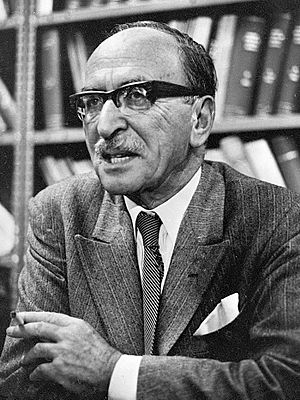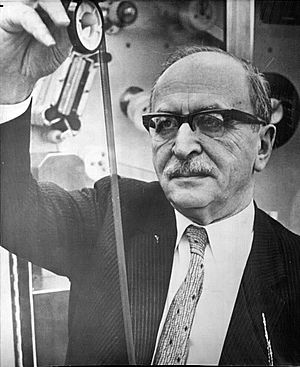Dennis Gabor facts for kids
Quick facts for kids
Dennis Gabor
|
|
|---|---|

Gabor, c. 1971
|
|
| Born |
Dénes Günszberg
5 June 1900 |
| Died | 9 February 1979 (aged 78) London, England
|
| Citizenship |
|
| Alma mater |
|
| Known for |
|
| Spouse(s) |
Marjorie Louise Butler
(m. 1936) |
| Awards |
|
| Scientific career | |
| Fields | |
| Institutions |
|
| Doctoral students |
|
Dennis Gabor was a brilliant Hungarian-British electrical engineer and physicist. He is most famous for inventing holography. This amazing invention earned him the 1971 Nobel Prize in Physics. Gabor became a British citizen in 1934. He spent most of his life living and working in England.
Life and Discoveries
Dennis Gabor was born as Dénes Günszberg in Budapest, Hungary, on June 5, 1900. His family changed their last name to Gábor in 1902. As a young man, he served in the Hungarian army during World War I.
He started studying engineering at the Technical University of Budapest in 1918. Later, he continued his studies in Germany at the Charlottenburg Technical University in Berlin. This school is now known as the Technical University of Berlin.
Gabor became very interested in how electrons behave. He studied high-voltage electric lines using special tools called cathode-beam oscillographs. This led him to explore other electron devices, like electron microscopes and TV tubes. In 1927, he earned his PhD. His work focused on recording electrical changes using cathode ray oscillographs.
In 1933, Gabor had to leave Nazi Germany due to the difficult political situation. He was invited to Britain to work at the British Thomson-Houston company. This company was located in Rugby, Warwickshire. While working there, he met Marjorie Louise Butler. They got married in 1936.
He became a British citizen in 1946. It was at British Thomson-Houston that he made his most famous invention: holography, in 1947. He used a special mercury arc light source for his early experiments. However, the first clear hologram was not made until 1964. This was possible after the invention of the laser in 1960. Lasers provided the perfect type of light needed for holography. After this, holography became widely used.
Gabor's research looked at how to get all the information from light. Regular cameras only capture the brightness of light. Gabor realized that to get a complete 3D picture, you also need to capture the "phase" of the light. This means how the light waves are lined up. By capturing both, he could create a full, 3D image, which is what a hologram is. He wrote many papers about his ideas between 1946 and 1951.
He also studied how humans communicate and hear sounds. His ideas led to something called granular synthesis. This is a way of creating sounds from tiny pieces. Gabor's work helped develop time–frequency analysis. This is a method used to understand how signals change over time.
In 1948, Gabor moved to Imperial College London. He became a professor of Applied Physics in 1958. He retired from this role in 1967.
In 1963, Gabor wrote a book called Inventing the Future. In this book, he talked about big challenges facing society. He believed that "the future cannot be predicted, but futures can be invented." This means we can work to create the future we want. His next book, Innovations, published in 1970, explored how new technologies can both help and harm society.
In 1971, Dennis Gabor received the Nobel Prize in Physics. He was honored "for his invention and development of the holographic method." In his Nobel lecture, he shared the story of how holography came to be.
Even after retiring, Gabor stayed involved with Imperial College. He also worked with CBS Laboratories in the United States. He collaborated with his friend Dr. Peter C. Goldmark on new communication ideas. One of Imperial College's student halls is named Gabor Hall in his honor. He also became interested in social issues. He joined the Club of Rome, a group that studies global challenges. He helped lead a group that looked at energy and technology. Their report, Beyond the Age of Waste, warned about issues that are still important today.
Thanks to the quick growth of lasers, holography became very popular. It is used in art, for storing information, and for recognizing patterns. Gabor received many awards during his lifetime, not just the Nobel Prize.
Dennis Gabor passed away in London on February 9, 1979. A special blue plaque was placed on his former home in Kensington. This plaque honors important people who lived there.
Personal Life
Dennis Gabor married Marjorie Louise Butler on August 8, 1936. They had a happy marriage. They did not have any children.
Awards and Honors
- Fellow of the Royal Society (1956)
- Honorary Member of the Hungarian Academy of Sciences (1964)
- D.Sc., University of London (1964)
- Young Medal and Prize for research in optics (1967)
- Columbus Award of the International Institute for Communications (1967)
- Albert A. Michelson Medal from The Franklin Institute (1968)
- Rumford Medal of the Royal Society (1968)
- Honorary Doctorate, University of Southampton (1970)
- Medal of Honor of the Institute of Electrical and Electronics Engineers (1970)
- Commander of the Order of the British Empire (CBE) (1970)
- Nobel Prize in Physics for holography (1971)
- Honorary Doctorate, Delft University of Technology (1971)
- Holweck Prize of the Société Française de Physique (1972)
- The International Society for Optical Engineering (SPIE) created the annual Dennis Gabor Award (1983)
- The Royal Society of London began issuing the Gabor Medal (1989)
- Gábor Dénes College in Budapest, Hungary, is named after Gabor (1992)
- The NOVOFER Foundation established its annual International Dennis Gabor Award (1993)
- The asteroid 72071 Gábor is named after Gabor (2000)
- The Institute of Physics renamed its Duddell Medal and Prize to the Dennis Gabor Medal and Prize (2008)
- Imperial College London opened the Gabor Hall (2009)
- Dennis-Gabor-Straße in Potsdam is named in his honor.
See also
 In Spanish: Dennis Gabor para niños
In Spanish: Dennis Gabor para niños
- Adaptive Gabor representation
- Gabor expansion
- Gabor frame
- Microsound
- Meniscus corrector
- Gábor Dénes College


